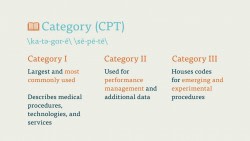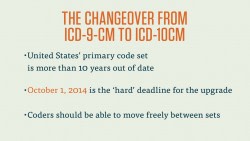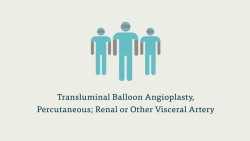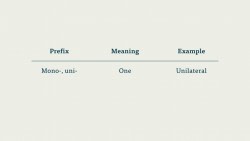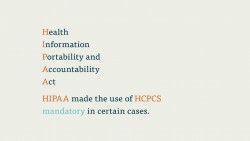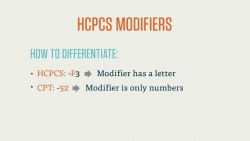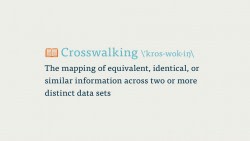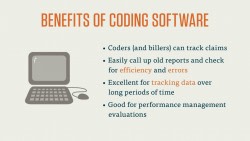There are a number of important terms you’ll want to familiarize yourself with as you learn more about coding. Let’s look at some of these now.
Category (CPT)
The CPT code set is divided into three Categories. Category I, which is the largest and most commonly used, describes medical procedures, technologies and services. Category II is used for performance management and additional data. Category III houses the codes for emerging and experimental medical procedures and services.
Category (ICD)
In ICD, the category is the first three characters of the code, which describes the basic manifestation of the injury or sickness. In some cases, the category is all that is needed to accurately describe the condition of the patient, but more often than not the coder must list a more detailed description of the injury or illness (see “Subcategory,” and “Subclassification”). In ICD-10-CM, categories are three numbers.
Clinical Modification
This designation, created by the National Center for Health Statistics, is added to the ICD codes sets when they are implemented in the United States. Many countries expand and clarify ICD code sets for their national use; the US, for example, expanded ICD-10 from 14,000 codes to over 68,000 individual codes. This term is abbreviated “-CM” and is added to the end of the ICD code title. For instance, ICD-10-CM can be read “International Classification of Diseases, Tenth Revision, Clinical Modification.
CMS
The Center for Medicare and Medicaid Services. This federal agency updates and maintains the HCPCS code set and is one of the most important organizations in healthcare today.
CPT
Current Procedural Terminology. Published, copyrighted, and maintained by the American Medical Association, CPT is a large set of codes that describe what procedure or service was performed on a patient. This code is divided into three Categories, with the first Category being the most important and widely used. CPT codes are an integral part of the reimbursement process. These codes are five characters long and may be numeric or alphanumeric.
HCPCS
Healthcare Common Procedure Coding System, pronounced hick-picks. This is main procedural code set for reporting procedures to Medicare, Medicaid, and a large number of other third-party payers. Maintained by CMS (See “CMS”), HCPCS is divided into two levels. Level I is identical to CPT, and is used in the same way. Level II describes the equipment, medication, and out-patient services not included in CPT.
E-codes
E-codes are a set of ICD-10-CM codes that includes codes for external causes of injury, such as auto accidents, poisoning, and homicide.
Evaluation and Management (CPT)
Evaluation and Management, or E&M, is a section of CPT codes used to describe the assessment of a patient’s health and the management of their care. The codes for visits to doctor’s office and trips to the emergency room, for instance, are included in E&M. E&M is found at the front of the CPT manual, despite being out of numerical order. The codes for E&M are 99201 – 99499.
ICD
The International Classification of Diseases is a set of medical diagnostic codes established over a hundred years ago. Maintained today by the WHO (See “WHO”), ICD codes create a universal language for reporting diseases and injury. Currently, we use ICD-10-CM (See “Clinical Modification”). ICD codes are numeric or alphanumeric. They have a three-character category (See “category (ICD)”), which describes the injury or disease, which is typically followed by a decimal point and two-to-four more characters, depending on the code set, which give more information about the manifestation and/or location of the disease.
Modifier
A modifier is a two-character code that is added to a procedure code to demonstrate an important variation that does not, by itself, change the definition of the procedure. CPT codes have numeric modifiers, while HCPCS codes have alphanumeric modifiers. These are added at the end of a code with a hyphen, and may provide information about the procedure itself, that’s procedure’s Medicare eligibility, and a host of other important facets. The CPT modifier -51, for example, notifies the payer that this procedure was one of multiple procedures. The HCPCS modifier –LT, on the other hand, describes a bilateral procedure that was performed only on the left side of the body.
Modifier Exempt (CPT)
Certain codes in CPT cannot have modifiers added to them. This is a fairly short list that can be found in the appendices of the CPT manual.
NCHS
The National Center for Health Statistics. The NCHS is a government agency that tracks health information, and is responsible for creating and publishing both the clinical modifications to ICD codes (See “Clinical Modification”) and their annual updates.
Pathology
The science of the causes and effects of disease.
Subcategory
In ICD codes, the subcategory describes the digit that comes after the decimal point. This digit further describes the nature of the illness or injury, and gives additional information as to its location or manifestation.
Subclassification
The subclassification follows the subcategory (See “Subcategory”) in ICD codes. The subclassification further expands on the subcategory, and gives additional information about the manifestation, severity, or location of the injury or disease. In ICD-10-CM there is also a subclassification that describes which encounter this is for the doctor—whether this is a first treatment for the ailment, a follow-up, or the assessment of a condition that is the result of a previous injury or disease (See “Sequela”). There may be as many as three subclassification characters in ICD-10-CM.
Technical component
The portion of a medical procedure that concerns only the technical aspect of the procedure, but not the interpretative, or professional aspect (See “Professional component”). A technical component might include the administration of a chest X-ray, but would not include the assessment of that X-ray for disease or abnormality.
WHO
The World Health Organization. This international body, which is an agency of the United Nations, oversees the creation of ICD codes and is one of the most important organizations in international health.
Z-codes
These codes describe circumstances outside of injury or disease that cause a patient to visit a health professional. This may include a patient visiting a doctor because of family medical history.

